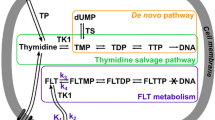Abstract
Objective
Thymidine phosphorylase (TP) is a key enzyme in the pyrimidine nucleoside salvage pathway and its expression is upregulated in a wide variety of solid tumors. In mice, we previously observed high and specific accumulation levels of our TP imaging probe, radioiodinated 5-iodo-6-[(2-iminoimidazolidinyl)methyl]uracil (IIMU) not only in high-TP-expressing tumors, but also in the liver and small intestine. To clarify the reason for the high accumulation levels of radioiodinated IIMU in the liver and small intestine, we investigated the expression levels of TP in mice in comparison with the biodistribution of radioiodinated IIMU (123I-IIMU).
Methods
BALB/cCrSlc mice were injected with 123I-IIMU, and the radioactivity levels [%ID/g (normalized to a mouse of 25 g body weight)] in the tissues of interest were determined 0.5, 1, 3 and 24 h after the injection (n = 5, each time point). To determine the expression levels of TP, BALB/cCrSlc and ddy mice (n = 3/each strain) were euthanized, and the heart, liver, lung, spleen, kidney, stomach, small intestine, large intestine and brain were collected. The mRNA and protein expression levels of TP in these organs were examined by quantitative reverse transcription-polymerase chain reaction and western blot analyses, respectively.
Results
In BALB/cCrSlc mice administered 123I-IIMU, markedly high radioactivity levels were observed in the liver [1.568 ± 0.237 (%ID/g)] and small intestine [0.506 ± 0.082 (%ID/g)], whereas those in the other tissues were fairly low [<0.010 ± 0.003 (%ID/g)] 30 min after the injection. The highest expression levels of TP mRNA were also observed in the liver and small intestine among the tissues tested. Immunoblotting showed intense immunoreactive bands of the TP protein for the liver and small intestine, whereas no notable bands were detected for other tissues. Similar expression profiles of TP mRNA and protein were observed in ddy mice.
Conclusion
We confirmed TP expression in various tissues of mice at the mRNA and protein levels: high TP expression levels were observed in the liver and small intestine. These high TP expression levels are consistent with the high accumulation levels of 123I-IIMU in these tissues. Our results may provide important information about the physiological accumulation of 123I-IIMU, which may be useful for the clinical diagnostic imaging of TP.


Similar content being viewed by others
References
Bronckaers A, Gago F, Balzarini J, Liekens S. The dual role of thymidine phosphorylase in cancer development and chemotherapy. Med Res Rev. 2009;29(6):903–53.
Moghaddam A, Zhang HT, Fan TP, Hu DE, Lees VeC, Turley H, et al. Thymidine phosphorylase is angiogenic and promotes tumor growth. Proc Natl Acad Sci USA. 1995;92(4):998–1002.
Miyadera K, Sumizawa T, Haraguchi M, Yoshida H, Konstanty W, Yamada Y, et al. Role of thymidine phosphorylase activity in the angiogenic effect of platelet derived endothelial cell growth factor/thymidine phosphorylase. Cancer Res. 1995;55(8):1687–90.
Harino Y, Imura S, Kanemura H, Morine Y, Fujii M, Ikegami T, et al. Role of tumor angiogenesis in gallbladder carcinoma: with special reference to thymidine phosphorylase. Int J Clin Oncol. 2008;13(5):452–7.
Han HS, Hwang TS. Angiogenesis in gastric cancer: importance of the thymidine phosphorylase expression of cancer cells as an angiogenic factor. Oncol Rep. 2007;17(1):61–5.
Takayama T, Mugiya S, Sugiyama T, Aoki T, Furuse H, Liu H, et al. High levels of thymidine phosphorylase as an independent prognostic factor in renal cell carcinoma. Jpn J Clin Oncol. 2006;36(9):564–9.
Chen LC, Hsueh C, Tsang NM, Liang Y, Chang KP, Hao SP, et al. Heterogeneous ribonucleoprotein k and thymidine phosphorylase are independent prognostic and therapeutic markers for nasopharyngeal carcinoma. Clin Cancer Res. 2008;14(12):3807–13.
Schwartz EL, Baptiste N, Wadler S, Makower D. Thymidine phosphorylase mediates the sensitivity of human colon carcinoma cells to 5-fluorouracil. J Biol Chem. 1995;270(32):19073–7.
Tokunaga Y, Hosogi H, Hoppou T, Nakagami M, Tokuka A, Ohsumi K. Prognostic value of thymidine phosphorylase/platelet-derived endothelial cell growth factor in advanced colorectal cancer after surgery: evaluation with a new monoclonal antibody. Surgery. 2002;131(5):541–7.
Takahashi M, Seki K, Nishijima K, Zhao S, Kuge Y, Tamaki N, et al. Synthesis of a radioiodinated thymidine phosphorylase inhibitor and its preliminary evaluation as a potential SPECT tracer for angiogenic enzyme expression. J Label Compd Radiopharm. 2008;51(11):384–7.
Akizawa H, Zhao S, Takahashi M, Nishijima K, Kuge Y, Tamaki N, et al. In vitro and in vivo evaluations of a radioiodinated thymidine phosphorylase inhibitor as a tumor diagnostic agent for angiogenic enzyme imaging. Nucl Med Biol. 2010;37(4):427–32.
Li H, Zhao S, Jin Y, Nishijima K, Akizawa H, Ohkura K, et al. Radiolabeled uracil derivative as a novel SPECT probe for thymidine phosphorylase: suppressed accumulation into tumor cells by target gene knockdown. Nucl Med Commun. 2011;32(12):1211–5.
Nishijima K, Zhao S, Zhao Y, Feng F, Shimizu Y, Abo N, et al. Preparation and evaluation of [123I]IIMU for SPECT imaging of thymidine phosphorylase expression in tumors. J Label Compd Radiopharm. 2013;56:S349.
Haraguchi M, Tsujimoto H, Fukushima M, Higuchi I, Kuribayashi H, Utsumi H, et al. Targeted deletion of both thymidine phosphorylase and uridine phosphorylase and consequent disorders in mice. Mol Cell Biol. 2002;22(14):5212–21.
Friedkin M, Roberts D. The enzymatic synthesis of nucleosides. I. Thymidine phosphorylase in mammalian tissue. J Biol Chem. 1954;207(1):245–56.
Boschetti E, D’Alessandro R, Bianco F, Carelli V, Cenacchi G, Pinna AD, et al. Liver as a source for thymidine phosphorylase replacement in mitochondrial neurogastrointestinal encephalomyopathy. PLoS One. 2014;9(5):e96692.
Acknowledgments
This study was supported (in part) by the Creation of Innovation Centers for Advanced Interdisciplinary Research Areas Program, Ministry of Education, Culture, Sports, Science and Technology, Japan. We also thank Nihon Medi-Physics Co., Ltd., for providing 123I-NaI.
Conflict of interest
We declare no other potential conflict of interest relevant to this article.
Author information
Authors and Affiliations
Corresponding author
Rights and permissions
About this article
Cite this article
Zhao, S., Li, H., Nishijima, Ki. et al. Relationship between biodistribution of a novel thymidine phosphorylase (TP) imaging probe and TP expression levels in normal mice. Ann Nucl Med 29, 582–587 (2015). https://doi.org/10.1007/s12149-015-0981-7
Received:
Accepted:
Published:
Issue Date:
DOI: https://doi.org/10.1007/s12149-015-0981-7




